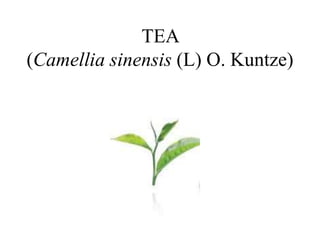Tea (Camellia sinensis) was first discovered in China around 2700 BC. There are two main varieties - Camellia sinensis var. sinensis from China and Camellia sinensis var. assamica from India. Tea is processed into either black tea through fermentation or green tea without fermentation. Successful tea cultivation requires specific climate and soil conditions, including rainfall between 1500-4000 mm annually, temperatures between 18-20°C, and acidic soils between pH 4.5-5.5. Tea is propagated through vegetative cuttings and established as a plantation with nursery preparation, planting, mulching, windbreaks, and management to bring the tea plants into bearing and yield.
















































